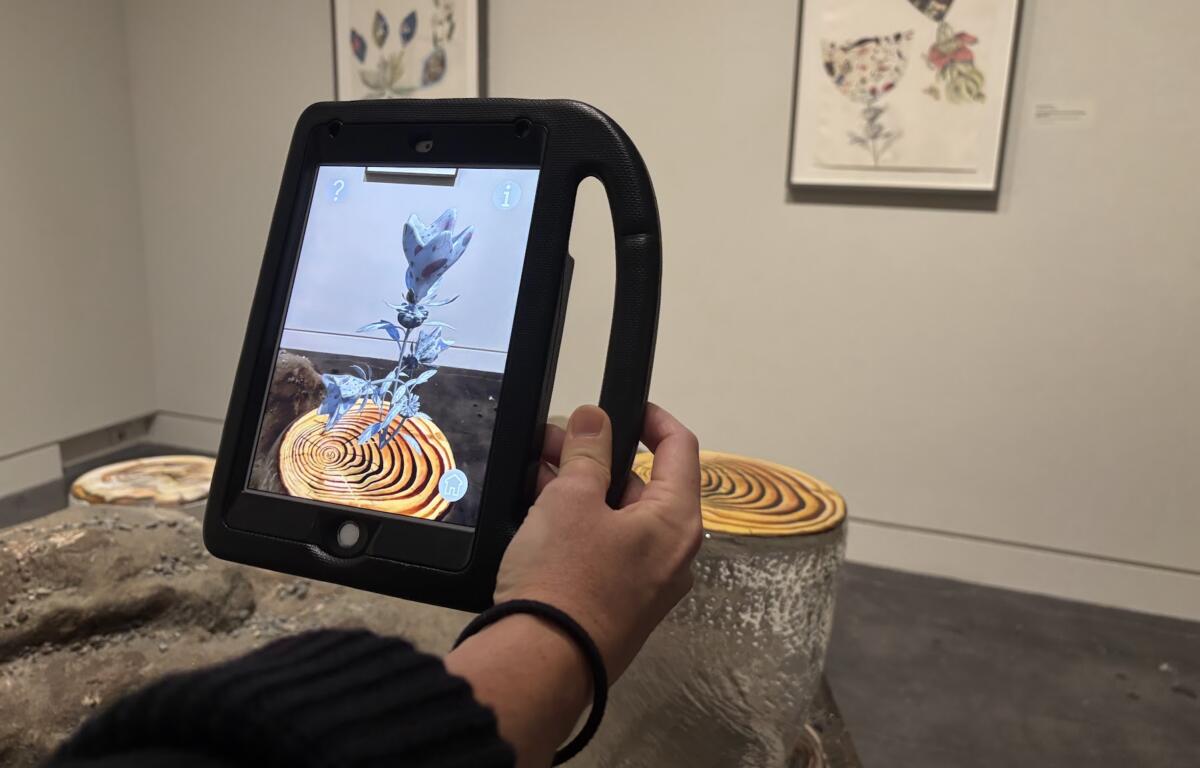ASHEVILLE, N.C. (828newsNOW) — A new exhibit at the Asheville Art Museum will be receiving its flowers as it opens to the public later this week. You just can’t see them.
The exhibition pair, “Moving Stillness: Mount Rainier” by Bill Viola and “Reforestation of the Imagination” by Ginny Ruffner, will be open at the museum beginning Friday, Sept. 13, through Jan. 20, 2025.
The two artists’ exhibits are meaningfully linked. Both utilize digital mechanics to explore representations of environmental devastation.
For Viola, a projected image of Pacific Northwest volcano Mount Rainier is thrown into a dizzying array of red, blue and green light when a pool of water beneath the projection is periodically disrupted.
Ruffner collaborated with digital media artist Grant Kirkpatrick to create her exhibit, a room filled with glass and plaster stumps that is transformed into a garden of post-apocalyptic Augmented Reality plants when viewed through a special app.

The interactive nature of the exhibit is something the museum hopes will drive visitors to see it, said Jessica Orzulak, an associate curator and Curatorial Affairs Manager for the Asheville Art Museum.
“I think the interactive element is really lovely. There’s not a lot of opportunities within something like an art museum to come in and actually interact with the space. Lots of Do Not Touch signs,” Orzulak said. “You’re asked to be sort of distant and look at objects from afar, and with this, you have to interact to really engage with the work.”
Orzulak hopes parents and kids alike will enjoy working with the exhibit since families will be using devices exciting to kids to approach the artwork. The goal is to teach about environmental disasters through new forms of media.
“Looking at the different ways that new media has transformed the ways that we think about human impact on the environment,” Orzulak explained.

Visitors can view the AR component of the exhibit by downloading the app, called “Reforestation,” on their own devices or by picking up one of the iPads the museum has provided for the experience. To look at Ruffner’s and Kirkpatrick’s flowers, visitors center their in-app camera on one of the tree stump’s rings. Suddenly, the flower comes to life onscreen, colorful, strange and surreal.
The digital flowers are adaptations of a series of odd paintings Ruffner created of her apocalyptic flora. Those portraits hang on the walls around her tree stump wasteland.
“They’re very surreal and fantastical. Very colorful,” Orzulak said.
Where the Ruffner room is brightly lit and surprising at every corner, the Viola piece of the exhibit is cast in darkness and inevitability.
The Mount Rainier projection is accompanied by a soundtrack of nature sounds. The noise is pumped into the dark room and fills the empty corners with life. The rectangular pool of water lays tranquil normally and while the image of the mountain changes slightly from time to time, it takes human interference for the exhibit to take its full effect. Every five minutes, a museum attendant will disturb the water, creating the color explosion in place of the calm mountain.
The exhibit seems to be saying that human beings are the only ones disrupting the calm natural environment, even when it comes to the most explosive natural things we have.

When a human hand is more destructive than a volcano, a powerful image is created. The augmented reality the exhibit proposed has never felt more real.
More information about Viola, Ruffner and the other exhibits at the Asheville Art Museum can be found on the museum website, www.ashevilleart.org.


